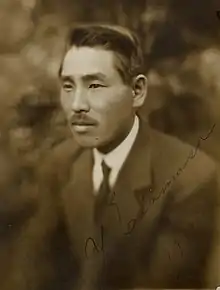Yoshirō Edamasa | |
|---|---|
 Edamasa in 1919 | |
| Born | 22 September 1888 |
| Died | 8 September 1944 (aged 55) |
| Nationality | Japanese |
| Occupation | Film director |
| Years active | 1914-1934 |
Yoshirō Edamasa (枝正 義郎, Edamasa Yoshirō, 22 September 1888 – 8 September 1944) was a Japanese film director best known for Sakamoto Ryoma (1928) and The Great Buddha Arrival (1934).[2] The latter film is one of the earliest tokusatsu movies, which is exemplified by kaiju movies.[3] He was an early pioneer of Japanese cinema who trained many outstanding directors and cinematographers including Eiji Tsuburaya.[4]
Life
Edamasa was born in Kushima, Saeki, Hiroshima Prefecture (present-day Hatsukaichi, Hiroshima).[5]
In 1910, he began working in the film industry when he was hired by Yoshizawa Shōten.[1] He later worked as an operator also for Fukuhōdō , Tōyō Shōkai and Tenkatsu Nippori.[1]
He made his debut as a director in 1919 on the film Ai no kyoku which was considered to be one of the most advanced films of that time.[6] By the end of the 1930s, Edamasa had directed more than 20 films.[1]
Edamasa belonged to a group of directors who emphasized the realistic style of acting.[7]
Selected filmography
- Yoshitsune sembon zakura[8] (1914) - Cinematographer
- Ninjutsu kaiso Koga Saburou (1918) - Cinematographer[8]
- Momochi sandayu (1918) - Cinematographer[8]
- Ai no kyoku (1919) - Director and Cinematographer
- Awaremi no kyoku (1919) - Director[8]
- Shima no tsuka (1920) - Director[8]
- Korokuden (1924) - Director
- Fuyuki shinju[8] (1924) - Director[8]
- Sakamoto Ryoma [8](1928) - Director[8]
- Tsukigata hanpeita (1929) - Director
- Higo no komageta[8] (1929) - Director
- kōboro kakū no kyōjin[8] (1932) - Director
- The Great Buddha Arrival (1934)[9] - Director (Last work)[9]
References
- 1 2 3 4 Komatsu, Hiroshi; Abel, Richard (2005). Encyclopedia of Early Cinema. London: Routledge. p. 199. ISBN 0-415-23440-9.
- ↑ "Films directed by Yoshiro Edamasa". letterboxd.com. Retrieved 7 December 2020.
- ↑ "Amazon.com: The Great Buddha Arrival : Hiroto Yokokawa: Prime Video". www.amazon.com. Retrieved 30 April 2023.
- ↑ Yamamoto, Akira (1982). Hiroshima Encyclopedia (1). Chugoku Shimbun. p. 147.
- ↑ Yamamoto, Akira (1982). 広島県大百科事典(上). 中国新聞社. p. 147.
- ↑ Lee, Daw-Ming (2012). Historical Dictionary of Taiwan Cinema. Scarecrow Press. p. 37. ISBN 978-0-8108-7922-5.
- ↑ "Początki kina w Japonii – multimedialny wykład dra Jakuba Karpoluka". www.iluzjon.fn.org.pl. Retrieved 13 July 2021.
- 1 2 3 4 5 6 7 8 9 10 11 "Yoshiro Edamasa". IMDb. Retrieved 7 December 2020.
- 1 2 "Godzilla-Italia - Scheda Regista: Yoshiro Edamasa". www.fantaclassici.com. Retrieved 7 December 2020.